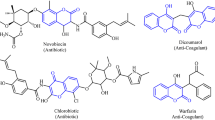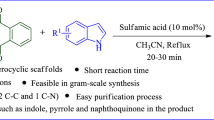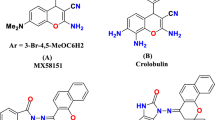Abstract
Methylene bridged ethers obtained from the reaction of 8-hydroxy quinoline and 4-bromomethyl coumarins and 1-aza-coumarins have been found to exhibit a broad spectrum of anti-microbial activity against both gram positive and gram negative bacterial strains. Modeling studies predict higher hydrophilicities for the compounds which are indicated by their lower LogP values. Gel electrophoresis has revealed their ability to cleave E. coli DNA. Structures have been confirmed by spectroscopic and single crystal X-ray diffraction studies.






Similar content being viewed by others
References
Murray RDH (2002) Progress in the chemistry of organic natural products. Springer, Wien
Kulkarni MV, Kulkarni GM, Lin CH, Sun CM (2006) Coumarins and 1-azacoumarins as biodynamic agents. Curr Med Chem 13:2795–2818
Fylaktakidou KC, Litina DJH, Litinas KE, Nicolaides DN (2004) Natural and synthetic coumarin derivatives with anti-inflammatory/antioxidant activities. Curr Pharm Des 10(30):3813–3833
Peng XM, Damu GLV, Zhou CH (2013) Current developments of coumarin compounds in medicinal chemistry. Curr Pharm Des 19(21):3884–3930
O’Donnell F, Smyth TJP, Ramachandran VN, Smyth WF (2010) A study of the antimicrobial activity of selected synthetic and naturally occurring quinolines. Int J Antimicrob Agents 35:30–38
Shukla OP (1989) Microbiological degradation of quinoline by pseudomonas stutzeri: the coumarin pathway of quinoline catabolism. Microbios 59:47–63
Bariana DS (1970) Coumarin derivatives as coronary vasodilators. J Med Chem 13(3):544–546
Buckle DR, Outred DJ, Ross JW, Smith H, Smith RJ, Spicer BA, Gasson BC (1979) Aryloxyalkyloxy- and aralkyloxy-4-hydroxy-3-nitrocoumarins which inhibit histamine release in the rat and also antagonize the effects of a slow reacting substance of anaphylaxis. J Med Chem 22(2):158–168
Basanagouda M, Kulkarni MV, Sharma D, Gupta VK, Pranesha Sandhyarani P, Rasal VP (2009) Synthesis of some new 4-aryloxymethylcoumarins and examination of their antimicrobial and antifungal activities. J Chem Sci 121:485–495
Merchant JR, Shah PJ (1981) Synthesis of 3-coumaryl phenyl sulfones or sulfoxides. J Heterocycl Chem 18:441–442
Kulkarni MV, Patil VD (1981) Studies on coumarins. Arch Pharm (Weinhiem) 314:708–711
Kulkarni GM, Patil VD, Kulkarni MV, Lakshmana M (1996) Synthesis, reactions, mass spectra and biological evaluation of some new 4-aryloxymethylcarbostyrils. J Indian Chem Soc 73:495–496
Shastri LA, Kulkarni MV (2004) Dual fluorescence and biological evaluation of paracetamol ethers from 4-bromomethyl coumarins. Ind J Chem 43(11):2416–2422
Sheelavantar RS, Alawandi GN, Kulkarni MV (2004) Some new biscoumarinyl ethers as analogues of lasiocephalin. Proc Natl Acad Sci India LXXIV A(II):87–98
Lakkannavar CD, Patil VD, Kulkarni MV (1991) Synthetic analogues of lasiocephalin. Natl Acad Sci Lett 14(1):25–27
Lin W, Yuan L, Cao Z, Feng J, Feng Y (2009) Fluorescence enhancement of coumarin–quinoline by transition metal ions: detection of paramagnetic Ni+2 and Co+2. Dyes Pigm 83(1):14–20
Paira P, Hazra A, Banerjee S, Gupta AD, Dastidar SG, Mondal NB (2009) Phase transfer catalyzed synthesis of bis-quinolines: antileishmanial activity in experimental visceral leishmaniasis and in vitro antibacterial evaluation. Eur J Med Chem 44:845–853
Okamoto T, Kobayashi T, Yoshida S (2007) Synthetic derivatives of osthole for the prevention of hepatitis. Med Chem 3(1):35–44
Tang JCO, Chan ASC, Lam KH, Chan SH (2012) Quinoline deraivatives as anti cancer agents. US patent no. 20120165370
Burger A, Ullyot GE (1947) Analgesic studies: β-ethyl and β-isopropylamine deriavatives of pyridine and thiazole. J Org Chem 12:342–355
Cook DJ, Bowen RE, Sorter P, Daniels E (1961) Bromination studies of Alkyl-substituted 2-pyridones and 2-quinolones. J Org Chem 26:4949–4955
Kulkarni MV, Pujar BG, Patil VD (1983) Studies on coumarin II. Arch Pharm (Weinhiem) 316:15–21
Revankar HM, Kulkarni MV, Anil KGN (2013) Crystal Structure of 6-methyl-4-[(quinolin-8-yloxy)methyl]-2H-chromen-2-one. X-ray Struct Anal Online 29:5–7
Kalkhambkar RG, Kulkarni GM, Kamanavalli CM, Premkumar N, Asdaq SMB, Sun CM (2008) Synthesis and biological activities of some new fluorinated coumarins and 1-aza coumarins. Eur J Med Chem 43:2178–2188
Schwalbe R, Steele ML, Goodwin AC (2007) Antimicrobial susceptibility testing protocol. CRC Press, Boca Raton
Sambrook J, Fritsch EF, Maniatis T (1989) Molecular cloning, a laboratory Manual, 2nd edn. Cold Spring Harbor Laboratory, Cold Spring Harbor, New York
Veber DF, Johnson SR, Cheng HY, Smith BR, Ward KW, Kopple KD (2002) Molecular properties that influence the oral bioavailability of drug candidates. J Med Chem 45(12):2615–2623
Acknowledgements
The authors thank NMR Research Center, Indian Institute of Science (IISc), Bangalore and University Sophisticated Instrumentation Center (USIC), Dharwad for spectral analysis. Authors acknowledge UGC for providing RFSMS scholarship.
Author information
Authors and Affiliations
Corresponding author
Ethics declarations
Conflict of interest
The authors declare no competing financial interest.
Rights and permissions
About this article
Cite this article
Revankar, H.M., Kulkarni, M.V. Hybrid Ethers of 8-Hydroxyquinoline and Coumarin, 1-Azacoumarin Moieties: Synthesis, Spectral Studies and Biological Evaluation. Proc. Natl. Acad. Sci., India, Sect. A Phys. Sci. 88, 1–8 (2018). https://doi.org/10.1007/s40010-016-0337-2
Received:
Revised:
Accepted:
Published:
Issue Date:
DOI: https://doi.org/10.1007/s40010-016-0337-2




